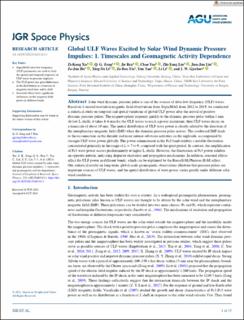Global ULF Waves Excited by Solar Wind Dynamic Pressure Impulses: 1. Timescales and Geomagnetic Activity Dependence
Xie, Zi-Kang; Zong, Q.G.; Ren, Jie; Yue, Chao; Liu, Zhi-Yang; Liu, Jian-Jun; Hu, Ze-Jun; Li, Xing-Yu; Yin, Ze-Fan; Yan, Yun; Li, Li; Gjerløv, Jesper
Journal article, Peer reviewed
Published version

Åpne
Permanent lenke
https://hdl.handle.net/11250/3124098Utgivelsesdato
2023Metadata
Vis full innførselSamlinger
Originalversjon
Journal of Geophysical Research (JGR): Space Physics. 2023, 128 (10), e2023JA031813. 10.1029/2023JA031813Sammendrag
Solar wind dynamic pressure pulse is one of the sources of ultra-low frequency (ULF) waves. Based on 1-second resolution magnetic field observations from SuperMAG from 2012 to 2019, we conducted a statistical study on temporal and spatial variations of global ULF power after the arrival of positive dynamic pressure pulses. The magnetosphere responds quickly to the dynamic pressure pulse within 1 min. At low L-shells, it takes 4–6 min for the ULF waves to reach a power maximum, then ULF waves decay on a timescale of about 10 min. The spatial distribution of ULF wave power is closely related to the direction of the interplanetary magnetic field (IMF) when the dynamic pressure pulse arrives. The southward IMF leads to the reconnection on the dayside and more intense substorm activities on the nightside, accompanied by stronger ULF wave power globally. The power enhancement in the Pc2 band exhibits a notable fluctuation concentrated primarily in the range of L = 7 to 9, compared with the quiet period. In contrast, the amplification of Pc3 wave power occurs predominantly at higher L-shells. However, the fluctuation of Pc5 power exhibits an opposite pattern, indicating disparate excitation and propagation mechanisms. In addition, seasonal effects affect the ULF power in different bands, which can be explained by the Russell-McPherron (R-M) effect. Our statistical results on long-term, global-scale geomagnetic observations illustrate that pressure pulses are important sources of ULF waves, and the spatial distribution of wave power varies greatly under different solar wind conditions.